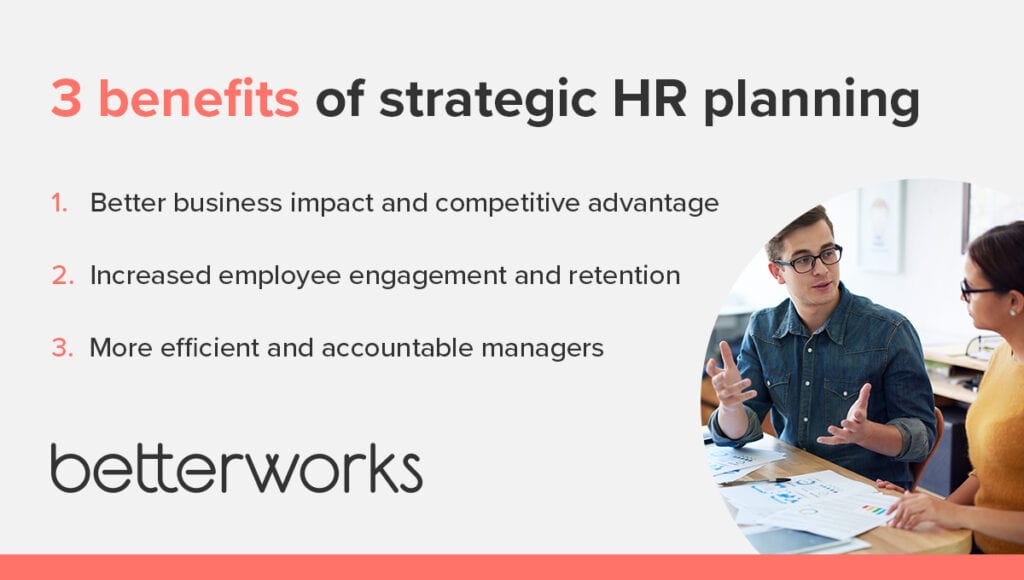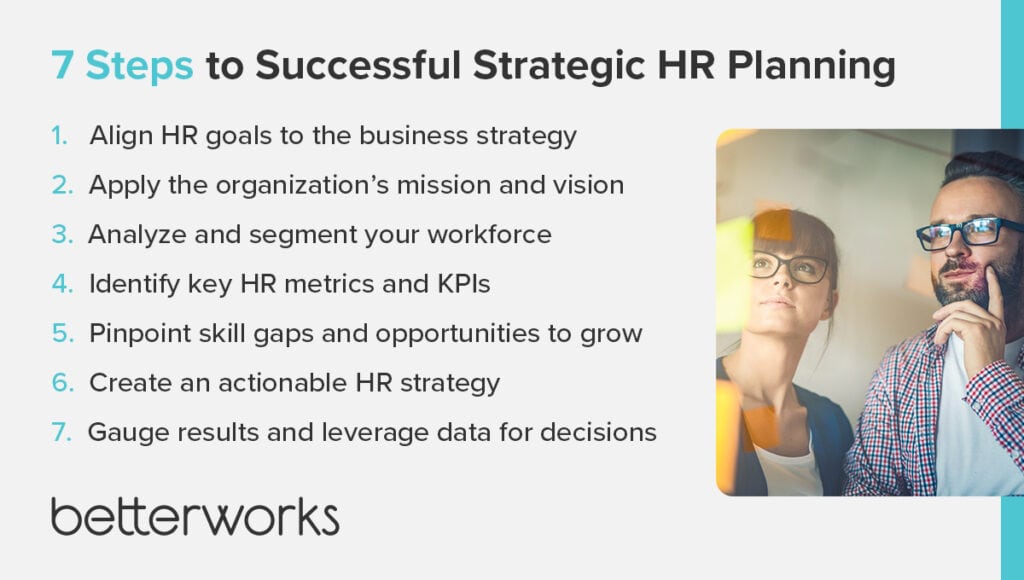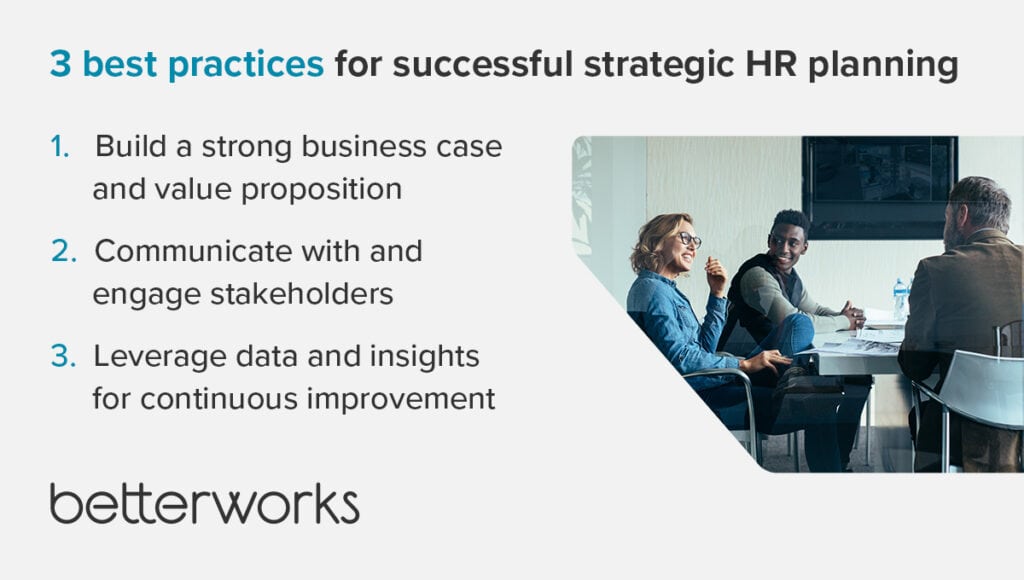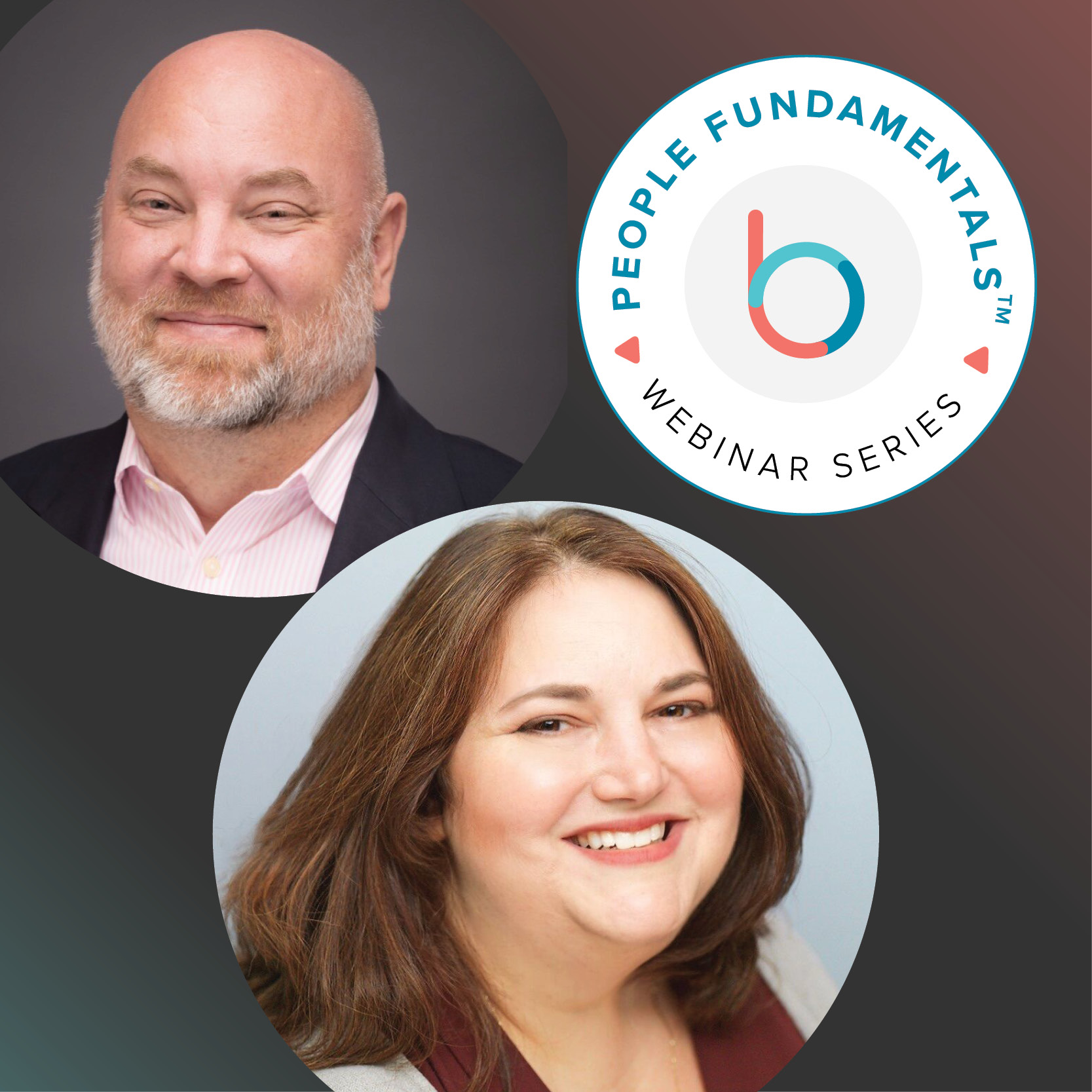- What is strategic planning for HR?
- 3 key elements of strategic HR planning
- 3 benefits of strategic HR planning
- 7 steps to successful strategic HR planning
- 3 common challenges to creating a strategic HR plan
- 3 best practices for driving strategic HR planning success
- Empower growth through strategic HR planning
Strategic HR planning belongs at the forefront of business strategy. If your human resources department isn’t in lockstep with the business, your organization can’t reach its potential.
Most CEOs agree: 89% surveyed by Accenture say their chief HR officer should have a lead role in driving long-term, profitable growth. They recognize that an effective HR strategy is a non-negotiable piece of an effective strategic business plan.
The key to strategic HR planning is framing your goals in terms of what drives the most value for the business. As you plot out future initiatives and programs, ask yourself: “What is the business need that is driving this project?” says Jamie Aitken, vice president of HR Transformation at Betterworks and co-author of “Make Work Better.” Think of the business strategy as your North Star.
Learn more about what strategic HR planning is, why it matters, and how to engage business leaders in the strategic HR planning process.
What is strategic planning for HR?
Strategic HR planning is the process of arranging your department’s resources, programs, and processes to put the most qualified people in the right roles to drive the highest possible business value. An effective plan gives the business a competitive edge by applying the workforce’s skills, abilities, and competencies in the most effective ways.
The HR strategic plan starts with analyzing your current state and identifying places you can improve. From there, you’ll set specific goals with road maps for achieving them. The process also considers external factors that could affect business growth, such as changing market demands, industry news, and economic fluctuations.
3 key elements of strategic HR planning
An effective strategic HR plan requires a solid basis in data. Check out these crucial elements to designing a sophisticated and actionable strategic HR plan.
Workforce data and analytics
Workforce data and analytics provide a competitive edge and enable business leaders to design informed, evidence-based HR strategies. With accurate and up-to-date data, organizations can align their HR initiatives with the evolving demands of their business, ensuring that they have the right people with the right skills in the right positions.
“The CEO will ask what are the best predictors of future performance and success? The chief strategy officer will ask, do we have engaged performers on our biggest initiatives? … If you have the data that are connected, you can answer these questions,” said Arnaud Grunwald, chief product officer at Betterworks, during the Betterworks webinar “Cracking the Code to Maximizing People ROI.”
Fueled by workforce data and analytics, you can develop a strategic HR plan to foster continuous improvement and evidence-based decision-making. An intuitive dashboard pulling your people data together allows you to ask intelligent questions that get at the real story behind the data.
In addition to tracking key performance metrics, such as employee turnover, retention rates, productivity, and training effectiveness, businesses can better understand the pre-cursors of these metrics by using analytics such as those available through Betterworks. HR leaders can measure activities like the frequency and quality of manager-employee conversations, the percentage of employees who are meeting their career development goals, and if and how employees are completing goals. With the right analytics, such as performance differences among groups by gender identity or ethnicity, businesses can better understand the effectiveness of their DEIB programs. Access to such data helps HR assess the effectiveness of its programs and make data-driven adjustments as necessary.
Clear workforce development opportunities
By pinpointing the workforce’s highest-potential opportunities, HR leaders can create HR strategic plans with the biggest possible impact and they can also use strategic plan templates for making the process easier. These opportunities change regularly because the skills your business needs are evolving. More businesses are integrating artificial intelligence (AI) into their operations, for example, and you need to develop employees’ ability to work with AI and improve overall performance.
Possessing solid workforce data and insights allows you to identify critical skill gaps, anticipate future talent needs, and develop targeted recruitment and development strategies to bridge those gaps. You must also consider attraction, retention, and succession planning. By mapping out career progression frameworks, offering training programs, mentorship initiatives, and employee development opportunities, businesses can inspire loyalty and create a culture of continuous learning.
Metrics for measuring success
Strategic HR planning must be measurable. By establishing clear and relevant metrics, you can track progress, identify areas of improvement, and make data-driven decisions to optimize your HR strategy, including adjustments along the way.
The metrics you track will differ depending on your goals. For example, when creating an internal talent marketplace, you might track talent mobility, internal fill rates, and workforce participation in training and development.
3 benefits of strategic HR planning
When executed effectively, strategic HR planning generates value for the business and for managers and employees. Here are three of the potential benefits you can derive from a strategic HR plan.
Better business impact and competitive advantage
Strategic HR planning drives higher business impact by aligning HR practices with overall business objectives. Executed well, an HR strategy can influence the attraction of top talent, foster employee engagement, and improve your organization’s ability to overcome HR challenges.
For example, your strategic HR plan might focus on robust recruitment and selection processes. By identifying the critical skills and competencies required for organizational success, strategic HR planning enables businesses to source and hire the best people for the job. This leads to a higher-quality workforce, increased productivity, and improved business performance.
In turn, having the right talent in place gives organizations a competitive edge by enabling them to deliver superior products or services, respond swiftly to market changes, and outperform their competitors.
Increased employee engagement and retention
Strategic HR planning doesn’t lump the entire workforce together as a unit. It recognizes the significance of aligning individual employees with company goals. As you account for business needs, you’re also creating learning pathways that help team members acquire new skills, knowledge, and experiences. The result is a workforce of individuals who have found their path to engagement and key competencies that generate business value.
This improves retention and your reputation as an employer of choice, helping you continue to attract high-potential individuals seeking growth-oriented workplaces.
More efficient and accountable managers
Strategic HR planning can improve manager efficiency and accountability within the business. When HR practices align with strategic objectives, managers have clarity on what they’re supposed to be doing, which then helps them guide their teams.
Transitioning from performance management to performance enablement, for example, provides a clear framework for managers to engage employees in performance conversations. Strategic HR planning in this context ensures that managers know how to effectively communicate expectations, track progress, and provide timely feedback to their team members.

7 steps to successful strategic HR planning
Now that we’ve defined strategic HR planning and why it matters, it’s time to get started in your organization. Follow these steps to kick off your strategic HR planning process.
Align HR goals to the business strategy
Within strategic HR plans, every HR initiative and action generates value for the business. Start by identifying the organization’s strategic priorities and determining how HR initiatives support and contribute to those goals. This involves evaluating workforce needs, skill requirements, and talent gaps that could prevent the business from achieving its goals.
Next, collaborate with key stakeholders, such as senior management and department heads, to gain insights into their specific goals and challenges. Working together helps build alignment and ensures that HR goals and initiatives are tailored to address the unique needs of different departments or functions. Use design thinking to best understand how people experience your processes now and how to develop ones in the future that will properly address their needs and challenges.
Apply the organization’s mission and vision
Your company’s mission and vision statements can illuminate purpose and business direction — and inform your strategic HR management plan, too. A mission statement summarizes the company’s primary objectives, while a vision statement is a declaration of what the organization aspires to be and hopes to achieve.
By incorporating the company’s mission and vision into HR strategies, policies, and practices, HR leaders ensure that the workforce’s efforts align with core values and long-term objectives.
Analyze and segment your workforce
A critical step in strategic HR planning is conducting a comprehensive workforce analysis. This involves such actions as analyzing demographic trends, evaluating skill sets, and identifying potential areas of improvement.
By segmenting the workforce based on factors such as roles, departments, and skill levels, HR leaders can develop targeted strategies to address the distinct needs and requirements of different employee groups. The result is more tailored workforce planning and resource allocation rather than a one-size-fits-all approach.
Identify key HR metrics and KPIs
To measure the success and impact of HR initiatives, it’s essential to identify important HR metrics and key performance indicators (KPIs). These measurements should align with the strategic objectives of the organization and provide meaningful insights into HR’s contribution to overall business outcomes.
Pinpoint skill gaps and opportunities to grow
A critical aspect of strategic HR planning is identifying skill gaps and opportunities for employee growth and development. By conducting skill assessments, evaluating job requirements, and analyzing future business needs, HR leaders can pinpoint strengths — and areas where the organization lacks the necessary skills or competencies.
A thorough skills inventory helps HR leaders design targeted training and development programs, succession planning initiatives, and recruitment strategies — all in pursuit of a future-ready workforce.
Create an actionable HR strategy
Your HR strategy is the outcome of the HR planning process. It should outline the specific actions, initiatives, and programs that will occur — and how these steps will align HR practices with the organization’s goals and objectives. Detail the timelines, assign responsibilities, and explain how resources will be allocated.
If one of your goals is to improve employee training and development programs, for example, you’d start with a needs assessment based on the business strategy. From there, you’d design and prepare to implement targeted training and development programs by establishing clear budgets, timelines, and accountability for launching the program.
Gauge results and leverage data for decisions
Your work doesn’t stop just because your strategic HR plan is in motion. It’s crucial to continuously track and assess the results of new or evolving HR initiatives with relevant workforce metrics.
Compare current progress against past outcomes to discover whether the plan is succeeding and how it’s driving business value (or not). Sophisticated use of analytics in HR can help you tease out which factors have the greatest impact on business success.

3 common challenges to creating a strategic HR plan
HR planning can be a daunting task, especially in large organizations. Everyone in the organization is a stakeholder in the process. Here are some of the challenges you may encounter during the planning process.
Lack of executive buy-in and support
If business leaders don’t fully comprehend the value and impact of strategic HR planning, they may question its relevance and importance. Often, leaders are simply more comfortable maintaining the status quo than investing in changes.
But the risk of inaction could be dire. Without a strategic HR plan uniting the workforce, employees are at higher risk of misalignment with the organization’s goals, leading to lower engagement and productivity. This can lead to a drop in profitability or the loss of highly qualified talent — neither of which businesses can afford in a highly competitive market.
Before addressing the rest of the leadership team, consider each stakeholder’s needs. What are their unique aspirations and pain points? When you address their concerns, you help them feel better about the HR strategic plan — and how it will help the entire organization.
Resistance to change and adoption
Implementing new HR strategies, processes, or technologies often requires a shift in mindset and behavior. This type of change frequently generates resistance from employees and other stakeholders.
Overcoming this resistance requires effective change management, including strong communication and helping employees feel like they’re actively contributing to planning and decision-making processes. HR leaders need to listen deeply, address concerns, demonstrate the benefits of the changes, and provide support and training to facilitate smooth adoption and implementation.
Limited resources and budgets
HR initiatives require sufficient funding and resources to be successful, but this isn’t easy to procure. HR leaders need to ruthlessly prioritize, explore cost-effective solutions, and advocate for the resources they need. Another way to overcome internal funding or resource constraints is by partnering with external providers.
3 best practices for driving strategic HR planning success
There are a few constants that improve the outcomes of your planning process every time. Follow these best practices to enhance your HR planning process.
Build a strong business case and value proposition
By presenting a successful business case, HR leaders can secure buy-in from senior management, gain support from stakeholders, and allocate the necessary resources for successful implementation.
This involves aligning HR goals with the overall business strategy, identifying key pain points or opportunities, and quantifying the impact that strategic HR planning can have on organizational performance.
Communicate with and engage stakeholders
HR leaders should involve key stakeholders from the early stages of the planning process, making sure that their perspectives and input are considered. Regular and transparent communication helps to build trust, manage expectations, and gain support for HR initiatives.
Start by asking simple, goal-oriented questions. “What are the biggest business challenges that you’re having?” Aitken says. “And how can we support from a people perspective?”
Engage stakeholders in conversations through workshops and feedback sessions. Soliciting stakeholder input fosters a sense of ownership and alignment with the strategic HR plan, increasing your chances of successful implementation.
Leverage data and insights for continuous improvement
Regularly reviewing and analyzing data allows for agile decision-making and ensures that HR initiatives remain aligned with changing business needs and priorities. By leveraging data, organizations can gain insights into the effectiveness of HR strategies, identify areas for improvement, and adjust plans as needed.

Empower growth through strategic HR planning
HR strategic planning is an important step for any organization. When done correctly, HR leaders can help the business meet its immediate objectives while establishing a strong foundation for the future.
With a solid strategy in place, organizations can more easily adapt to changing business conditions and position themselves for long-term success. By taking the time to develop the right strategic HR plan, you can capitalize on any opportunities that come your way.
Want to learn more? Check out “Maximizing HR Impact: Your Strategic HRM Plan Explained.”



